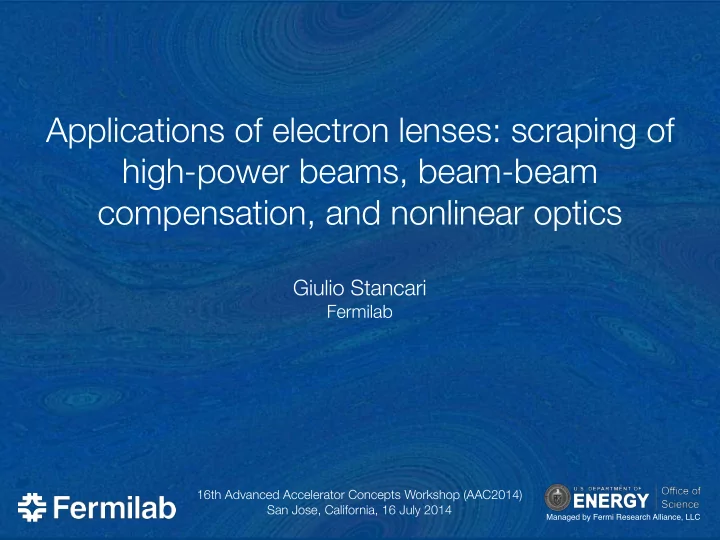

Applications of electron lenses: scraping of high-power beams, beam-beam compensation, and nonlinear optics Giulio Stancari Fermilab 16th Advanced Accelerator Concepts Workshop (AAC2014) San Jose, California, 16 July 2014 Managed by Fermi Research Alliance, LLC
Contributors R. Bruce, S. Redaelli, A. Rossi, B. Salvachua Ferrando (CERN) A. Valishev (Fermilab) Many thanks to O. Aberle, A. Bertarelli, F . Bertinelli, O. Brüning, G. Bregliozzi, P . Chiggiato, S. Claudet, R. Jones, Y. Muttoni, L. Rossi, B. Salvant, H. Schmickler, R. Steinhagen, G. Tranquille, G. Valentino (CERN), V. Moens (EPFL), G. Annala, G. Apollinari, M. Chung, T. Johnson, I. Morozov, S. Nagaitsev, E. Prebys, V. Previtali, G. Saewert, V. Shiltsev, D. Still, L. Vorobiev (Fermilab), R. Assmann (DESY), M. Blaskiewicz, W. Fischer, X. Gu (BNL), D. Grote (LLNL), H. J. Lee (Pusan National U., Korea), S. Li (Stanford U.), A. Kabantsev (UC San Diego), T. Markiewicz (SLAC), D. Shatilov (BINP) Giulio Stancari [Fermilab] — Electron lenses: halo scraping, beam-beam compensation, nonlinear optics — AAC14 : San Jose : 16 July 2014 2
Outline ‣ Introduction ‣ What’s an electron lens? What can it be used for? ‣ Hollow electron beam collimation ‣ Concept and experimental demostration at the Tevatron ‣ Proton halo in the LHC ‣ A design of hollow electron beam scraper for the LHC ‣ parameters, simulations, hardware, integration ‣ Long-range beam-beam compensation for the LHC upgrades ‣ Motivation, preliminary considerations, integration ‣ Nonlinear dynamics in the Fermilab Integrable Optics Test Accelerator (IOTA) ‣ Conclusions
What’s an electron lens? • Pulsed, magnetically confined, low-energy electron beam • Circulating beam a ff ected by electromagnetic fields generated by electrons • Stability provided by strong axial magnetic fields superconducting solenoid 6 m total length 1–6 T protons electrons antiprotons 3-m overlap region collector 5-kV, 1-A electron gun thermionic cathode Tevatron electron lens 200-ns rise time conventional solenoids 0.1–0.4 T Shiltsev et al., Phys. Rev. ST Accel. Beams 11 , 103501 (2008) Giulio Stancari [Fermilab] — Electron lenses: halo scraping, beam-beam compensation, nonlinear optics — AAC14 : San Jose : 16 July 2014 4
Electron gun Superconducting solenoid Collector Electron lens (TEL-2) in the Tevatron tunnel
First main feature: control of electron beam profile Current density profile of electron beam is shaped by cathode and electrode geometry and maintained by strong solenoidal fields Flat profiles for bunch-by-bunch betatron tune correction ● ● ● ● 0.8 CURRENT DENSITY (a.u.) ● ● ● 0.6 ● ● ● ● ● ● ● ● ● ● Hollow profile ● ● ● ● ● ● ● ● ● ● ● ● 0.4 ● ● for halo scraping ● ● 0.2 ● ● ● ● ● ● ● ● ● ● ● ● ● ● ● ● ● ● ● ● ● ● ● ● ● ● ● ● ● ● ● ● ● ● ● ● ● ● ● ● ● ● ● ● ● ● ● ● ● ● ● ● ● ● ● ● ● ● ● ● ● ● ● ● ● ● ● − 10 − 5 0 5 10 X (mm) Gaussian profile for compensation of 7.75 A nonlinear beam-beam forces 0.3 T 0.05 kV 0.00146 A n = 0.05988 Giulio Stancari [Fermilab] — Electron lenses: halo scraping, beam-beam compensation, nonlinear optics — AAC14 : San Jose : 16 July 2014 6
Second main feature: pulsed electron beam operation Beam synchronization in the Tevatron bunch spacing: 396 ns MODULATOR (4 kV/V) PROTON BUNCHES: P1 P2 P3 TEL2 PICKUP A13 A14 A15 ANTIPROTON BUNCHES: COLLECTOR (1 A/V) Pulsed electron beam could be synchronized with any group of bunches , with a di ff erent intensity for each bunch Giulio Stancari [Fermilab] — Electron lenses: halo scraping, beam-beam compensation, nonlinear optics — AAC14 : San Jose : 16 July 2014 7
Applications of electron lenses In the Fermilab Tevatron collider ‣ long-range beam-beam compensation (tune shift of individual bunches) ‣ Shiltsev et al., Phys. Rev. Lett. 99 , 244801 (2007) ‣ abort-gap cleaning (for years of regular operations) ‣ Zhang et al., Phys. Rev. ST Accel. Beams 11 , 051002 (2008) ‣ studies of head-on beam-beam compensation ‣ Stancari and Valishev, FERMILAB-CONF-13-046-APC ‣ demonstration of halo scraping with hollow electron beams Tevatron electron lenses ‣ Stancari et al., Phys. Rev. Lett. 107 , 084802 (2011) TEL-‐‒2 CDF Presently, being commissioned in RHIC at BNL ‣ head-on beam-beam compensation ‣ X. Gu’s talk at this workshop TEL-‐‒1 0.98-‐‒TeV antiprotons Current areas of research ‣ generation of nonlinear integrable lattices 0.98-‐‒TeV in the Fermilab Integrable Optics Test Accelerator ‣ hollow electron beam scraping of protons in LHC protons ‣ long-range beam-beam compensation as charged, current-carrying “wires” for LHC DZero ‣ to generate tune spread for Landau damping of instabilities before collisions in LHC 2 ¡km Giulio Stancari [Fermilab] — Electron lenses: halo scraping, beam-beam compensation, nonlinear optics — AAC14 : San Jose : 16 July 2014 8
Outline ‣ Introduction ‣ What’s an electron lens? What can it be used for? ‣ Hollow electron beam collimation ‣ Concept and experimental demostration at the Tevatron ‣ Proton halo in the LHC ‣ A design of hollow electron beam scraper for the LHC ‣ parameters, simulations, hardware, integration ‣ Long-range beam-beam compensation for the LHC upgrades ‣ Motivation, preliminary considerations, integration ‣ Nonlinear dynamics in the Fermilab Integrable Optics Test Accelerator (IOTA) ‣ Conclusions
Recommend
More recommend